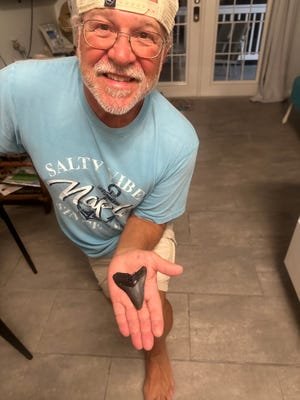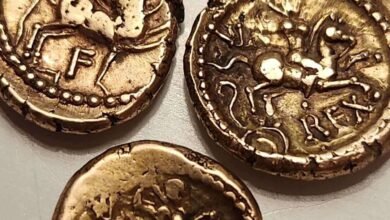Large megalodon tooth found on Florida beach by Michigan man

Cassie Shivley remembered the conversation she had with her father. He wanted to go for a walk on the beach and had one thing in mind.
Shivley’s father, Brad Vanderstow, lives in central Michigan. He is spending two months on vacation in Florida this winter. He enjoyed searching for shells on Satellite Beach and Fort Myers Beach. On March 6, he visited Stump Pass on South Englewood Beach, south of Sarasota.
“He found a whole bunch of small (shark) teeth and was hoping to find at least one decent-sized one for a necklace,” Shivley said. “He jokingly told me that he wanted to find a megalodon tooth after he started finding the little ones.”
Vanderstow, 64, found one. A large.
It was around 6:30 p.m., Shivley said. Her father was just finishing his walk on the beach.
“My dad looked down and searched,” Shivley said. “He saw something black mostly buried in the sand and decided to check it out.”
It was a megalodon tooth. And it was significantly larger than the tiny shark teeth he had already collected. Shivley said the buried treasure her father discovered was 3 1/4 inches long.
It was one of those moments you never forget.

“My mother said he could barely speak as he tried to say her name and get her attention when he found it,” Shivley said. “He immediately FaceTimed us to show his two granddaughters and me. It’s safe to say he won’t be able to look up for the rest of their stay on the beach.”
According to the website fossilera.com, the standard measurement for megalodon teeth is the bevel height, or the longest edge of the tooth. Adult Megalodon teeth were typically in the 4 to 5 inch range; Teeth over 6 inches are rare and represent oversized individuals. Only a handful of teeth larger than seven inches have ever been found.
The tooth Vanderstow now has is certainly too large for a necklace, but he plans to keep the tooth as a keepsake, Shivley said.

What is a Megalodon?
According to National Geographic Kids“the most famous prehistoric shark, Carcharocles megalodon, Nicknamed Megalodon or Megatooth, it ruled the seas from about 17 million years ago to almost three million years ago. The colossal predator reached up to 60 feet in length and was as long as a boxcar. The only marine animal ever heavier than the megalodon is the blue whale, which weighs up to 200 tons, just over twice the size of a megalodon.
- A megalodon’s bite could crush a car.
- The largest megalodon tooth ever discovered was about the length of a television remote control.
- Megalodon had a bite force at least three times stronger than T Rex.



